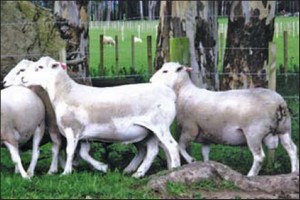NZ Farmer, March 9, 2017
Finnish student impresses Hawke’s Bay ram breeder
-By Kate Taylor / Fairfax
A Hawke’s Bay ram breeder has had hundreds of students through his gates, but none quite like Silja Alamikkotervo, he tells Kate Taylor
Not only does the One Stop Ram Shop offer a variety of sheep breeds, but there’s usually a variety of nationalities as well. Hundreds of students and woofers have been through its gates but none have impressed host Robin Hilson as much as Finnish teenager Silja Alamikkotervo. “She has been the most outstanding of the lot,” he says. “People contribute in different ways but her skill levels are outstanding. She’s conscientious, patient and has fantastic stock sense. She was originally only coming for three or four months but fitted in so well we put her on the payroll.”
Since arriving in Hawke’s Bay last May, Silja (pronounced Celia) has been working as a general shepherd on the 200ha Takapau property. She has joined the Ashley Clinton-Norsewood Young Farmers Club and travels around the country with Hilson visiting ram clients and properties grazing One Stop Ram Shop ewes. She loves New Zealand’s dog trials and is training young heading dog, Meg. She has not only learned to shear but did a great job on rams earlier this month before travelling to the Golden Shears to see how the professionals do it. “We shear them standing up at home but I wanted to learn how to do it the correct way. I was trying to learn on You Tube but all the people were right-handed and I am not. “It was a great and very entertaining event. I just love watching shearing . . . it’s amazing how fast those top shearers can do it and the quality of shearing and animal handling still remains good as well.”
Silja is studying animal science at Helsinki University about 750km south of her family farm in Tervola in Southern Lapland, 80km south of the Arctic Circle (latitude 66deg north). Ninety hectares of flat land is used for grazing and cropping (silage and barley and oats for winter stock food). Silja’s mother runs the farm, which isn’t unsual in Finland, while family members help with cultivation, sowing and harvesting. Silja could drive a tractor when she was just six or seven years old. “My parents finished university and started farming in 1995 and I was born in 1996 so I have seen the farm grow from just three ewes and a ram to now 150 ewes and 20 sire rams. That’s a normal-size farm in Finland. But being small is normal because all those animals have to be housed inside for eight months a year. We’re also subsidised through the EU so there are many rules and regulations for farmers in Finland.”
Temperatures in Tervola range from an average -15 degrees Celsius in winter with extremes of -30C to a summer average of 15C with extremes of 30C. There are 24 hours of daylight at the height of summer and 24 hours of darkness in deep winter with snow lying for about five months.
The 150 registered finn ewes are mated in three flocks – 70 white, 40 black and 40 brown – with coloured wool scoured and the skins sold locally. Family members use machines to knit items such as scarves, socks and pants, which are sold across Finland in different markets and through their farm’s website (www.vanhalanlammastila.fi).
“It’s amazing how in NZ you have markets even for the belly wool and dags. Your whole wool industry is so different to us in Finland. In Finland even selling the good wool isn’t always easy and no way there would be markets for the belly wool or dags. Because of the difficulties to get wool sold in Finland, farmers often do like we do: get the wool spun into yarn and then sell it by themselves as yarns and knitted products. That way you can get much better profit. It is often the same with the skins as well. You get them professionally scoured and then sell them by yourself to make better profit. When the farms in Finland are only small, it’s possible to market all the wool and skins by yourself.”
Silja has learnt English at school since she was eight or nine years old (it is compulsory alongside Finnish and Swedish). She is expected to do work experience as part of her university studies. “Normally that is four months of work in Finland but I thought it was a good opportunity to travel. The first option was the UK but then I thought of New Zealand. I knew it had a lot of sheep, which I love to work with, and I had seen the Lord of the Rings movies and knew people who had visited.
“I have really enjoyed learning about New Zealand farming and teaching people more about Finland as well.” Silja returns home in May.
Ram breeder sends ewes away
Takapau ram breeder Robin Hilson loves the look on people’s faces when he tells them a large portion of his ewe flock has been sent to breed on different properties around the country. There are 11 farms from Southland to Hawke’s Bay with his ewes, including Hilson’s 200ha One Stop Ram Shop home block, Paratu, on the Takapau Plains.
“The ram business is our main enterprise but in the past few years I’ve started doing something I wanted to do years ago,” Hilson says. “Samples of my breeding ewes around the country prove how they manage in different environments. I’ve loved the exchange of ideas from all these landowners and it has turned into a wonderful comparison of what they can do and what we can’t do… and vice versa. “One of the things I have learnt so far is that the East Coast has a huge range of lurgies that literally put pressure on our animals all the way through – parasites, facial eczema, salmonella – and that exposure is an advantage to our breeding programmes. East Coast stock are do well anywhere,” he says.
“Silja has been doing the computer work for the Sheep Improvement Limited (SIL) recording. Putting data into the computer has been time-consuming because of the different timeframes of the different properties.” In the South Island, Hilson’s ewes can be found in Southland, South Canterbury, Marlborough and Nelson. In the North Island, they are on four properties around Takapau, two in Waipawa and at his partner Joy’s farm, The Glen, at Pauatahanui, Wellington. Hilson’s return for the arrangement is his choice of ram lambs at weaning.
“The main objective of the whole process is to fill the picture we want in terms of ram selling. Fertility, growth rates and survival are still key recording traits, so we measure those against the other breeds and against their immediate siblings once they’re back here. All progeny are fully recorded.”
He says results from the farm at Tapawera, near Nelson, have been revealing. Ewes sent in 2013 were stabilised quarter finn, quarter texel, half Perendale. Last season triplets were separated after scanning. “At weaning, about day 110, two ewes weaned a total of 93 and 94kg of lambs. Ewes weighed 61 and 62kgs each. Wonderful effort. A third ewe weighing 71.5kg weaned 116kgs of lamb. We have never approached this level of production in Hawke’s Bay. All nine lambs were killable,” he says. “The ewes themselves were not even huge sheep but it’s what they’ve done that’s huge. They’ve reared nine killable lambs with no special treatment. I’m not saying they could all do this, but it reveals their potential as a genetic package. This is the type of information we want for the whole industry to move forward. To get this information we need farmers who want to cooperate, as they do for One Stop Ram Shop.”
Hilson changed his own breeding ideals back in the 1987. He had a perendale stud when scientists approached him about the finn and texel sheep imported from Europe. “MAF’s growing flocks had nowhere to live.” He put together a joint venture between 43 farmers, the Ministry of Agriculture and NZ Sheepac Ltd and built a quarantine station on his farm. He says he found the finns were hardy, lived longer and were prolific breeders with facial eczema tolerance. Texels were tough and sported big, meaty back ends. The texel and finn were crossed with New Zealand breeds and performance-recorded. “Crossbreds out-performed New Zealand purebreds in quarantine.”
Hilson launched One Stop Ram Shop – a crossbreeding regime on his farm that now offers a variety of rams including finn, texel, dorper purebreds, stabilised finn-texel crossbreds with fixed proportions of finn, texel and New Zealand genetics. Texel-suffolk is a stabilised genotype. Rams are farmed NZ wide. Hilson is on the road for months at a time visiting the farmers around the country who buy his rams and he’s also taken that travel further afield to South America and Iran. He was part of a meeting arranged by the Middle East Business Council with the Iranian Foreign Minister last year after several visits to Iran since 2012.
KATE TAYLOR/FAIRFAX NZ

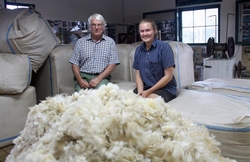
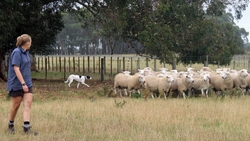


HB Today, November 2011
CHB ram breeder in Brazil
-By Kate de Lautour
Sheep genetics from the One Stop Ram Shop owned by Robin Hilson have been exported to countries around the world including Australia, Chile and the USA.
Following a recent visit to Brazil, there are two new countries set to benefit from the purebred and stabilised crossbred ram providers.
Brazilians can’t get enough sheep meat.
Currently 90% of lamb is supplied to Brazil from neighbouring Uruguay and the high quality Texel or Dorper meat is reserved for those wealthy enough to afford it… (read full article here)

CHB Mail, FARM FOCUS, May, 2011
Dayanne’s sharing a love of sheep
-By Nicki Harper
Dayanne Almeida is passionate about farming, sheep farming in particular, and for the past two years has been in New Zealand learning all she can about the industry.
Since arriving in Central Hawke’s Bay from Brazil in 2009 she has been working for Robin Hilson and Joy Gray at the One Stop Ram Shop in Takapau —adding practical knowledge to her Bachelor of Animal Science degree.
She studied in Sao Paulo, and to complete her papers had to find somewhere to do a six-month internship, the pursuit of which brought her up against some frustrating attitudes amongst Brazilian farmers.
“I got a job offer from the Dorper Sheep Breeder Association in Brazil. For three months I worked there trying to do things differently. These guys are not farmers; they are businessmen who run sheep as a hobby. It’s about having star sheep, which they will pay up to $500,000 for at auctions, but they are… (read full article here)
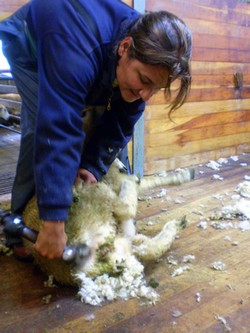
WEEKEND HERALD, April 24, 2010
The sorry yarn of wool
-By Geoff Cumming
One of the nation’s foundation industries has hit a new low with the axing of scientific efforts to boost market prospects. Geoff Cumming looks at the wool trade’s ravelled lines.
The rest of the world may think of New Zealand as one big sheep farm, but even Aucklanders know the image is outdated – it’s a long time since growing wool was either lucrative or a vital cog in our economy. But AgResearch’s decision to cull its wools and textiles division this week and axe 35 scientists should nevertheless make townies look up from their lattes long enough… (read full article here)

HAWKES BAY TODAY, April 29, 2010
“Where have they all gone? “
-By Richard Hilson of Takapau
Where have all the possums gone? My family and I live and farm in the south-eastern corner of the Pukenui Possum Control Area, where our corner boundary is bordered by State Highway 50 and the Makaretu River. Our property has been well covered in bait stations for several years now, with about 70 stations on Global Positioning Satellite (GPS) coordinates and bait and contract labour costing us about $400 per annum. But we don’t do a thing.
The problem is the programme has been way too successful. No longer can we find even one possum for the kids or a visitor. We still see plenty of rabbits and hares and we chase them day and night – but what about the possums? There now seems no point in looking up any of the trees around here with a spotlight. Places where we shot dozens of possums a night as kids are now just empty trees not worth an upward glance. It’s virtually impossible even to find a dead one . . . (read full article here . . .)

STRAIGHT FURROW, February 23, 2010
“Sheep numbers recovering,” says breeder
-By Rob Tipa
WAIPUKURAU ram breeder Robin Hilson of the One Stop Ram Shop is a big fan of the biennial Southern Field Days at Waimumu in eastern Southland.
“I’ve shown sheep throughout the country, but this show is the best,” he said. “It’s a real pleasure for us to come down from the North Island and experience southern hospitality.
Mr Hilson said sheep had special requirements to look after them during a three-day show and he was impressed by the effort and commitment of Southern Field Days volunteers to meet those needs.
Mr Hilson is confident of a recovery in sheep numbers, despite claims by pundits to the contrary, and he proved that by bringing stock from Hawke’s Bay to Southland for the field . . . . (read full article here . . .)
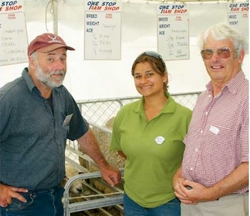
COUNTRY-WIDE PUBLICATIONS LTD.
Worldwide shortage of lamb good news for NZ
A worldwide shortage of sheepmeat offers real potential for growing sales of New Zealand lamb, says Robin Hilson, a director of the Texel Marketing Group and owner of the One Stop Ram Shop.
The Central Hawke’s Bay farmer is just back from a trip overseas to Scotland, Sweden, Finland, Belgium and the USA. He visited supermarkets and restaurants, finding out what the market is paying for lamb, and collecting quotes.
He says 5.6 million tonnes of sheepmeat are produced each year, but only one million tonnes is exported worldwide.”New Zealand and Australia dominate that and account for at least 800,000 tonnes.”
He says the market potential in the United States is huge, but full of challenges. The US, Mexico and Canada operate as a single market under the North American Free Trade Agreement. In population terms, there is more than 400 million people. The US has . . . (read full article here . . .)

RURAL CENTRAL DISTRICTS • October 2007
All-year lambing on way to becoming a reality
THE ABILITY to supply the market year-round with fresh lamb, which has reached a killable weight by weaning, would be a financial success story for any farmer.
All-year lambing is yet to be a commercial option for most farmers, but studies into the viability of putting the ram out three times a year suggest the practice will be a future reality.
Year-round lambing was first trialled by Robin Hilson, from the One Stop Ram Shop near Waipukurau, Central Hawke’s Bay, in the early 1990s.
Using Finns and Texels, Robin said that they managed the programme quite well. “We produced lots of extra lambs and speeded up the generation gap, but it was very costly.” The programme required many chemicals and supplementary feed. “It worked, because we got lambs on the ground, but it was very costly. You . . . (read full article here . . .)

RURAL CENTRAL DISTRICTS • October 2007
Dorper fertility ideal for lamb production
Dorpers are a South African creation, a cross between the Dorset and a Persian sheep. They are highly fertile, and the rams don’t experience the fertility down-time typical of other breeds from October to December.
Waipukurau breeder Robin Hilson first encountered Dorpers in South Africa and, though he recognised they were a hardy breed, he has been surprised with just how well they have stood up to the sparse feed conditions typical on the East Coast. “Its feed required for maintenance per kilo live weight is very low compared to other breeds. “The survivability has just got . . . (read full article here . . .)
